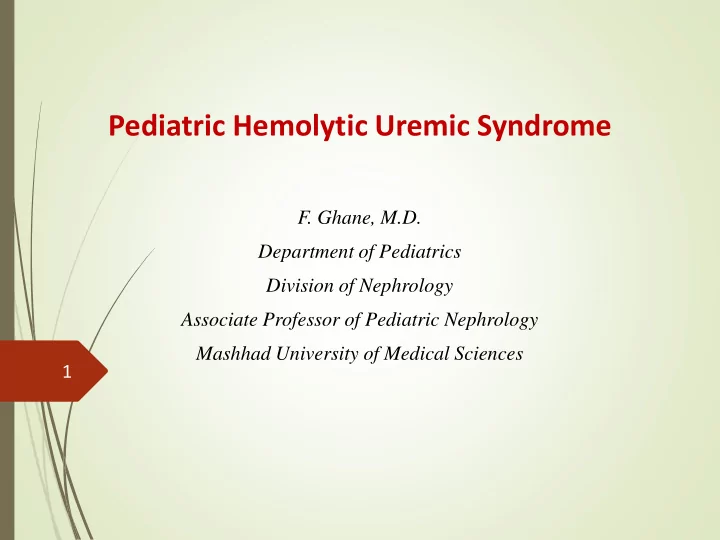

Pediatric Hemolytic Uremic Syndrome F. Ghane, M.D. Department of Pediatrics Division of Nephrology Associate Professor of Pediatric Nephrology Mashhad University of Medical Sciences 1
2 Hemolytic uremic syndrome (HUS) HUS, is a disease characterized by the classical triad : Acute renal failure of varying severity Microangiopathic anemia Thrombocytopenia of varying severity
3
Other clinical finding 4 Cerebral manifestations (cerebral edema, seizures, leukoencephalopathy, coma, and stroke) Cardiac dysfunction Gastrointestinal tract and liver dysfunction, including intestinal complications (necrosis, perforation) Panceratitis
5 HUS: Pathophysiology Infection related - Shigella/E.coli toxin (Typical HUS, Most common) - Pneumococcal infection - Viral infections (HIV) Complement abnormalities - Factor H deficiency - Factor 1 deficiency Miscellaneous ( Drugs, Malignancy) Other classification: Typical (Diarrhea positive , D+HUS) Atypical (5-10%) D-HUS
Typical HUS 6 Diarrhea positive (D+ HUS) Usually occurs after intestinal infection with Shiga-toxin-producing bacteria E.coli O157:H7 (shigatoxins 1 and 2) Shigella dysenteriae serotype 1, Salmonella Food borne disease: uncooked / unpasteurized products contaminated by animal wastes Most patients are <3 years of age though can occur in adults Pathophysiology : shigella-toxin binding protein on the surface of glomerular endothelium and inactivating a metalloproteinase called ADAMTS13.
Pathogenesis 7
Pathogenesis 8
9 L ong te r m r e sults (10- 20 ye ar s afte r HUS*) A severe condition: acute mortality (2.5%) associated with significant morbidity Complete recovery 63% Recovery with proteinuria 12% Recovery with proteinuria and HTN 6% Recovery with low GFR ± proteinuria or HTN, 16% ESRD, 3% * Diarrheal or URI- related only, pediatric
Acute Kidney Injury 10
Laboratory tests 11 CBC, peripheral smear, renal function studies, electrolytes, LDH, and urinalysis Coagulation studies including PT and PTT Testing for Shiga toxins (eg, ELISA) in the stool, stool cultures, and serologic testing for IgM and anti-lipopolysaccharide antibodies against the most frequent STEC serotypes. C3 levels should be part of every HUS evaluation(Save blood from before plasma exchange) ADAMSTS13 / auto-Ab analysis if TTP not ruled out
Treatment 12 The initial management of HUS is supportive Red blood cell transfusions for anemia when clinically indicated (HB 6 to 7 g/dL or HT <18 %). Platelet transfusion for patients with significant clinical bleeding or if an invasive procedure is required. Appropriate fluid and electrolyte management. Stopping nephrotoxic drugs. Management of hypertension Initiation of dialysis: symptomatic uremia, severe fluid overload, or electrolyte abnormality , refractory to medical therapy. Provision of adequate nutrition.
Atypical HUS 13 Usually due to disorders of complement regulation. About 50%-60% of aHUS cases are associated with a mutation in a complement-related gene. Empiric plasma therapy can delay or prevent ESRD in many of those cases. Risk of post-transplant recurrence depends on the specific disorder of complement regulation. Clinically very severe 15% died 25% ESRD 15% renal insufficiency 1/3 recover without significant renal disease Most (75%) have a single episode Few (25%) have recurrent aHUS
Complement and Atypical HUS Pro tein in Gen en e So u r o u rce L o catio n L o c o n % o o f f aHUS US CFH Liver circulates ~ 15-30% Fac acto r H H Fac acto r I I CFI Liver circulates ~ 5-10% Mem em b ran an e e MCP W idespread M embrane ~ 10-15% bound Co fa facto to r Pro tein in Fac acto r B B CFB Liver, ? circulates <5% C3 C3 C3 Liver, ? circulates ~ 5-10% CFHR1/ Lymphocyte circulates ~ 10% A n ti ti-FH FH-A b A b CFHR3 Un k n kn o w n o w n ~ 40-50% Jozsi et al. Blood 2008, Frémeaux-Bacchi V et al. Blood 2008, Goicoechea de Jorge 2007, Caprioli, et al Blood 2006, Kavanagh Curr Opin Nephrol Hypertens, 2007
15
Treatment 16 Plasma exchange is indicated for non-Shiga toxin-associated HUS Follow response with platelet count and LDH Platelet transfusion contraindicated Childhood E.coli-associated HUS does not warrant plasma therapy as it usually resolves spontaneously Plasmapheresis Plasma infusion (especially ADAMTS13) Eculizumab (binds to C5 and blocks C5 convertase)
Empiric Plasma Exchange 17 Diagnosis of HUS Atypical presentation Clinical Exceptions Plasma Exchange within 24 hrs 1.5 Volumes (60-75 ml/kg) per session FFP Repeat Plasma Exchange Daily x 5 Then 5 sessions/week for 2 weeks Then 3 sessions/week for 2 weeks Withdrawal Alternate Diagnosis Assess Outcome at Day 33 Plasma Exchange Complication Early remission Ariceta et al. Ped Neph 2009
Eculizumab 18 A monoclonal antibody to complement factor C5 Blocks complement activation, in treatment of patients with complement-mediated HUS. May also be beneficial in patients with STEC HUS and CNS involvement. The first report of three children with severe neurologic symptoms, resolution of neurologic symptoms 7 to 12 days after starting eculizumab. The possible complication of meningococcal infection needs appropriate vaccination before its use.
19
Recommend
More recommend